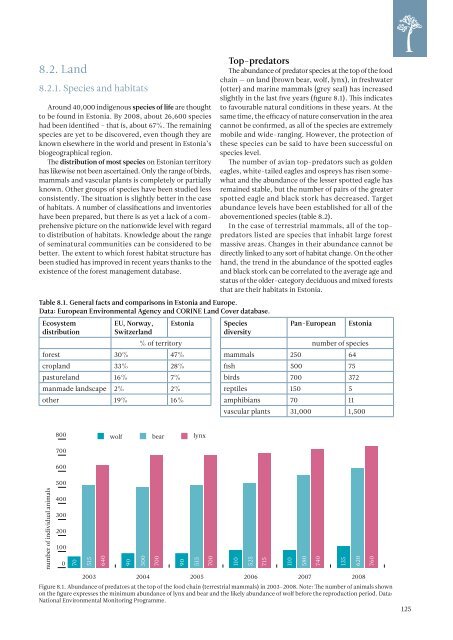ESTONIAN ENVIRONMENTAL REVIEW 2009
ESTONIAN ENVIRONMENTAL REVIEW 2009
ESTONIAN ENVIRONMENTAL REVIEW 2009
Create successful ePaper yourself
Turn your PDF publications into a flip-book with our unique Google optimized e-Paper software.
8.2. Land<br />
8.2.1. Species and habitats<br />
Around 40,000 indigenous species of life are thought<br />
to be found in Estonia. By 2008, about 26,600 species<br />
had been identified – that is, about 67%. The remaining<br />
species are yet to be discovered, even though they are<br />
known elsewhere in the world and present in Estonia’s<br />
biogeographical region.<br />
The distribution of most species on Estonian territory<br />
has likewise not been ascertained. Only the range of birds,<br />
mammals and vascular plants is completely or partially<br />
known. Other groups of species have been studied less<br />
consistently. The situation is slightly better in the case<br />
of habitats. A number of classifications and inventories<br />
have been prepared, but there is as yet a lack of a comprehensive<br />
picture on the nationwide level with regard<br />
to distribution of habitats. Knowledge about the range<br />
of seminatural communities can be considered to be<br />
better. The extent to which forest habitat structure has<br />
been studied has improved in recent years thanks to the<br />
existence of the forest management database.<br />
Table 8.1. General facts and comparisons in Estonia and Europe.<br />
Data: European Environmental Agency and CORINE Land Cover database.<br />
Ecosystem<br />
distribution<br />
EU, Norway,<br />
Switzerland<br />
% of territory<br />
Estonia<br />
forest 30% 47%<br />
cropland 33% 28%<br />
pastureland 16% 7%<br />
manmade landscape 2% 2%<br />
other 19% 16%<br />
Top-predators<br />
The abundance of predator species at the top of the food<br />
chain — on land (brown bear, wolf, lynx), in freshwater<br />
(otter) and marine mammals (grey seal) has increased<br />
slightly in the last five years (figure 8.1). This indicates<br />
to favourable natural conditions in these years. At the<br />
same time, the efficacy of nature conservation in the area<br />
cannot be confirmed, as all of the species are extremely<br />
mobile and wide-ranging. However, the protection of<br />
these species can be said to have been successful on<br />
species level.<br />
The number of avian top-predators such as golden<br />
eagles, white-tailed eagles and ospreys has risen somewhat<br />
and the abundance of the lesser spotted eagle has<br />
remained stable, but the number of pairs of the greater<br />
spotted eagle and black stork has decreased. Target<br />
abundance levels have been established for all of the<br />
abovementioned species (table 8.2).<br />
In the case of terrestrial mammals, all of the toppredators<br />
listed are species that inhabit large forest<br />
massive areas. Changes in their abundance cannot be<br />
directly linked to any sort of habitat change. On the other<br />
hand, the trend in the abundance of the spotted eagles<br />
and black stork can be correlated to the average age and<br />
status of the older-category deciduous and mixed forests<br />
that are their habitats in Estonia.<br />
Species<br />
diversity<br />
Pan-European<br />
Estonia<br />
number of species<br />
mammals 250 64<br />
fish 500 75<br />
birds 700 372<br />
reptiles 150 5<br />
amphibians 70 11<br />
vascular plants 31,000 1,500<br />
800 lynx<br />
bear<br />
wolf<br />
700<br />
600<br />
500<br />
number of individual animals<br />
400<br />
300<br />
200<br />
100<br />
0<br />
70<br />
515<br />
640<br />
90<br />
500<br />
700<br />
90<br />
515<br />
700<br />
2003 2004 2005 2006 2007 2008<br />
Figure 8.1. Abundance of predators at the top of the food chain (terrestrial mammals) in 2003–2008. Note: The number of animals shown<br />
on the figure expresses the minimum abundance of lynx and bear and the likely abundance of wolf before the reproduction period. Data:<br />
National Environmental Monitoring Programme.<br />
110<br />
525<br />
715<br />
110<br />
580<br />
740<br />
135<br />
620<br />
760<br />
125

















